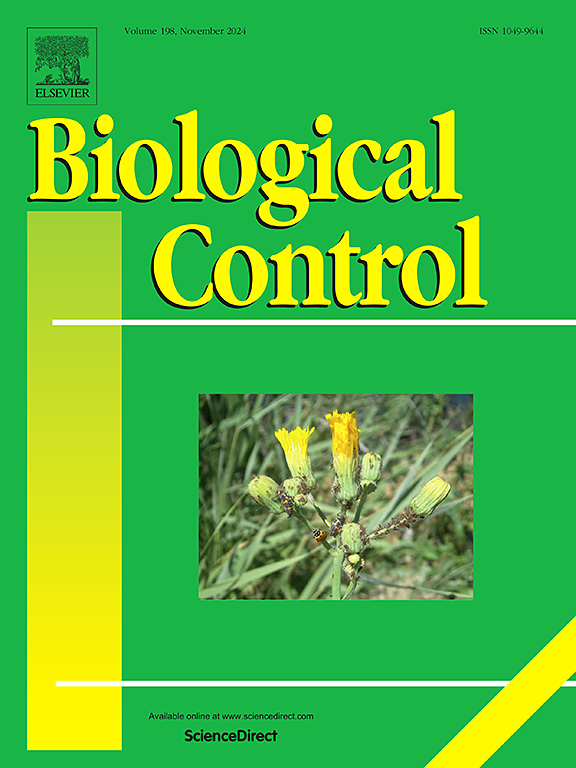Biological control and mechanism characterization of endophytic Bacillus velezensis SJ22 against bulb rot of Fritillaria taipaiensis P. Y. Li
IF 3.4
2区 农林科学
Q2 BIOTECHNOLOGY & APPLIED MICROBIOLOGY
引用次数: 0
Abstract
Bulb rot in Fritillaria taipaiensis P. Y. Li, caused by Fusarium spp., is a destructive soil-borne disease that severely affects the yield and quality of F. taipaiensis. Chemical fungicides are currently the primary means of controlling this disease; however, their use poses risks to human health and the environment. Biological control is thus a preferable alternative to counteract the threats associated with pathogens. In this study, an endophytic bacterium, designated SJ22, was isolated from bulb tissue of F. taipaiensis, and it exhibited significant antagonism against Fusarium spp., with inhibition rates on plates ranging from 84.35% to 89.96% and a control rate of 73.38% in pot experiments. Morphological observations and phylogenetic analyses identified the isolate SJ22 as Bacillus velezensis. Furthermore, the antifungal mechanisms of SJ22 include the inhibition of spore germination, alteration of hyphal morphology, and disruption of cell membrane integrity. Its volatile organic compounds exhibited broad-spectrum antifungal activity in vitro, with an inhibition rate of 28.36% to 59.12%, and demonstrated significant control efficacy in vivo. Transcriptome analysis revealed that SJ22 induced systemic resistance in F. taipaiensis by upregulating defense-related genes, primarily through enhancing the phenylpropanoid biosynthesis pathway and promoting the salicylic acid/ethylene signaling pathway to induce the production of pathogenesis-related proteins and increase the activity of defense-related enzymes. In summary, we isolated an endophytic bacterium that exerts its biocontrol function through both inhibiting pathogen growth and inducing resistance.

内生芽孢杆菌SJ22对太白贝母球茎腐病的生物防治及机理研究
太白贝母球茎腐病是由镰刀菌引起的一种严重影响太白贝母产量和品质的破坏性土传病害。化学杀菌剂是目前控制该病的主要手段;然而,它们的使用对人类健康和环境构成风险。因此,生物防治是对抗与病原体有关的威胁的较好选择。本研究从taibaiensis球茎组织中分离到一株内生细菌SJ22,该细菌对Fusarium spp.具有显著的拮抗作用,平板抑制率为84.35% ~ 89.96%,盆栽对照率为73.38%。形态学观察和系统发育分析表明,SJ22为芽孢杆菌。此外,SJ22的抗真菌机制包括抑制孢子萌发、改变菌丝形态和破坏细胞膜完整性。其挥发性有机物在体外表现出广谱的抑菌活性,抑菌率为28.36% ~ 59.12%,体内抑菌效果显著。转录组分析显示,SJ22通过上调防御相关基因诱导太白f的系统性抗性,主要通过增强苯丙类生物合成途径和促进水杨酸/乙烯信号通路,诱导致病相关蛋白的产生,提高防御相关酶的活性。综上所述,我们分离到了一种内生细菌,它通过抑制病原菌生长和诱导抗性来发挥其生物防治功能。
本文章由计算机程序翻译,如有差异,请以英文原文为准。
求助全文
约1分钟内获得全文
求助全文
来源期刊

Biological Control
生物-昆虫学
CiteScore
7.40
自引率
7.10%
发文量
220
审稿时长
63 days
期刊介绍:
Biological control is an environmentally sound and effective means of reducing or mitigating pests and pest effects through the use of natural enemies. The aim of Biological Control is to promote this science and technology through publication of original research articles and reviews of research and theory. The journal devotes a section to reports on biotechnologies dealing with the elucidation and use of genes or gene products for the enhancement of biological control agents.
The journal encompasses biological control of viral, microbial, nematode, insect, mite, weed, and vertebrate pests in agriculture, aquatic, forest, natural resource, stored product, and urban environments. Biological control of arthropod pests of human and domestic animals is also included. Ecological, molecular, and biotechnological approaches to the understanding of biological control are welcome.
 求助内容:
求助内容: 应助结果提醒方式:
应助结果提醒方式:


